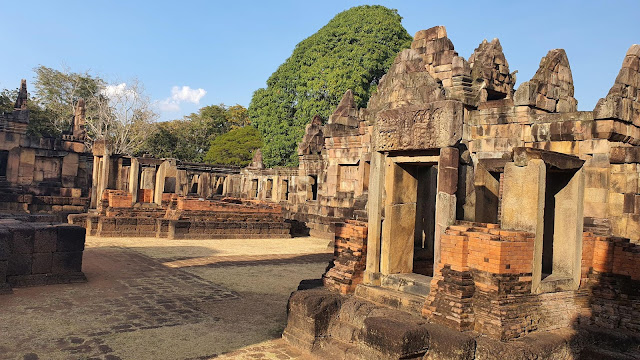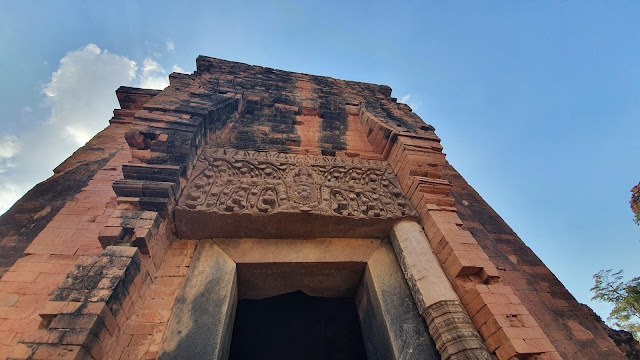ปราสาทหินที่ใหญ่ที่สุดในประเทศไทยนั้นก็คือ ปราสาทหินพิมาย ในเขตจังหวัดนครราชสีมา ซึ่งย่อมแสดงให้เห็นถึงความเป็นศูนย์กลางและเป็นปากประตูสําคัญจากลุ่มแม่น้ํามูลไปสู่เมืองพระนครของอาณาจักรกัมพูชา และบ้านเมืองในเขตลุ่มแน่น้ําเจ้าพระยา โบราณสถานที่ปรากฏอยู่ในเมืองพิมายนั้นปรากฏมีอยู่หลายแห่งทั้งนอกเมืองและในเมืองโบราณพิมาย แต่ที่สําคัญได้แก่ ปราสาทหินพิมาย
Prasat Hin Phimai is
the largest stone Khmer temple in Thailand in Nakhon Ratchasima province. It
points out being a center and a main starting point from Mun river basin to the
Angkor of Cambodia Kingdom and other states in the Chao Phraya river basin
area. Several ancient ruins in Phimai town still remain in and out Phimai
ancient town. However, the highlight is Prasat Hin Phimai.
Thank you
The Phimai Historical Park (Thai: ปราสาทหินพิมาย, pronounced is one of the largest Hindu Khmer temples in Thailand. It is located in the town of Phimai, Nakhon Ratchasima province. It is one of the most important tourist attractions in Nakhon Ratchasima province.
Phimai had previously been an important town at the time of the Khmer Empire. The temple Prasat Hin Phimai, located in the center of the town, was one of the major Khmer temples in ancient Thailand, connected with Angkor by an ancient Khmer Highway, and oriented to face Angkor as its cardinal direction. The site is now protected as the Phimai Historical Park.
อุทยานประวัติศาสตร์พิมาย เป็นปราสาทหินทรงขอมโบราณแบบบาปวน ตั้งอยู่ในอำเภอพิมาย จังหวัดนครราชสีมา ประกอบด้วยปราสาทหินในสมัยอาณาจักรขอมที่ใหญ่โตและงดงาม สร้างขึ้นในสมัยพระเจ้าสุริยวรมันที่ 1 ราวพุทธศตวรรษที่ 16 เพื่อใช้เป็นเทวสถานของศาสนาพราหมณ์ และเปลี่ยนเป็นพุทธศาสนานิกายมหายาน ในเวลาต่อมา
เมือง: อำเภอพิมาย, จังหวัดนครราชสีมา
เริ่มสร้าง: ราวพุทธศตวรรษที่ 16
ปรับปรุง: ราวพุทธศตวรรษที่ 17
ประเภท: ปราสาทหิน
Lintel on top of the northern entry to the main shrine in the Phimai temple in Phimai historical park, Nakhon Ratchasima, Thailand. It shows a lintel over the north entrance to the shrine with a 4-armed dancing Vishnu
Having a lot in common with Angkor Wat, Phimai is an example
of classical Khmer architecture. Ancient Khmer architects were best known for
their superior use of sandstone over the traditional bricks and laterite
architectures. Sandstone is used on the visible outer layer. Laterite on the
other hand was used for the inner wall and other hidden parts. All the
structures are huge sandstone blocks. There are many lotus-shaped roofs
representing Mount Meru (Hinduism's holy mountain).
Khmer temples in general, as well as Phimai in this case,
were intended to resemble the universe. The main building resembles the peak of
Mount Meru at the center of the universe. The surrounding walls resemble the
water and encircling mountains. The Khmer did not develop the technique of true
vault architecture during their time, results in large areas at Phimai that
could not be roofed over. They instead developed the use of multiple chapels
separated by open-air spaces.
มีหลายอย่างที่เหมือนกันกับนครวัด พิมายเป็นตัวอย่างของสถาปัตยกรรมเขมรคลาสสิก สถาปนิกชาวเขมรโบราณเป็นที่รู้จักกันดีที่สุดในการใช้หินทรายเหนืออิฐแบบดั้งเดิมและสถาปัตยกรรมศิลาแลง ใช้หินทรายกับชั้นนอกที่มองเห็นได้ ส่วนศิลาแลงใช้เป็นผนังด้านในและส่วนอื่นๆ ที่ซ่อนอยู่ โครงสร้างทั้งหมดเป็นบล็อกหินทรายขนาดใหญ่ มีหลังคารูปดอกบัวหลายหลังแสดงถึงเขาพระสุเมรุ (ภูเขาศักดิ์สิทธิ์ของศาสนาฮินดู)
วัดเขมรโดยทั่วไปเช่นเดียวกับพิมายในกรณีนี้มีจุดมุ่งหมายเพื่อให้คล้ายกับจักรวาล
อาคารหลักคล้ายกับยอดเขาพระสุเมรุ ณ ใจกลางจักรวาล
ผนังโดยรอบมีลักษณะคล้ายน้ำและล้อมรอบภูเขา
ชาวเขมรไม่ได้พัฒนาเทคนิคสถาปัตยกรรมหลุมฝังศพที่แท้จริงในช่วงเวลานั้น
ส่งผลให้พื้นที่ขนาดใหญ่ที่พิมายไม่สามารถมุงหลังคาได้
พวกเขาพัฒนาการใช้ห้องสวดมนต์หลายห้องซึ่งแยกจากกันด้วยพื้นที่เปิดโล่ง
ปราสาทหินที่หันหน้าไปทางทิศใต้ (ต่างจากปราสาทหินอื่น ๆ ที่หันหน้าไปทางทิศตะวันออก) ซึ่งสันนิษฐานว่าเพื่อให้หันรับกับเส้นทางที่ตัดมาจากเมืองยโศธรปุระ เมืองหลวงของอาณาจักรเขมร ที่เข้ามาสู่เมืองพิมายทางทิศใต้
ปราสาทหินที่ (นักวิชาการส่วนหนึ่ง)
เชื่อกันว่าเป็นต้นแบบของ “ปราสาทนครวัด“ สิ่งมหัศจรรย์ของโลกในกัมพูชา
ปราสาทหินที่สร้างขึ้นเพื่อเป็นพุทธสถานในลัทธิมหายาน เนื่องจากพระเจ้าสุริยวรมันที่ 1 และพระเจ้าชัย
วรมันที่ 7
ทรงนับถือพุทธศาสนาลัทธิมหายาน






































No comments:
Post a Comment